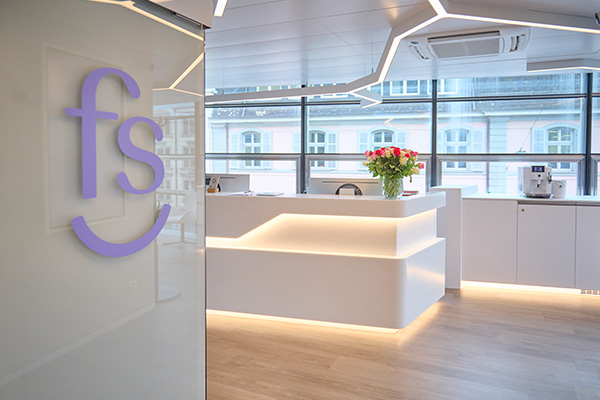Facts about caries treatment with composite fillings

What is a composite filling?
Filling made of a special composite material in the color of the natural teeth
Range of applications:
- Anterior region: fillings, incisal edge build-ups, enlargement of pivot teeth, accidental teeth
- Posterior teeth: replacement of smaller amalgam fillings, initial treatment of smaller tooth defects)
Duration of treatment:
30 to 60 minutes depending on scope
What is a composite filling?
A composite filling is a dental filling made from a special plastic mixture of organic and inorganic materials. This mixture in turn consists of tiny glass and ceramic particles (around 80%) and plastic (around 20%). In an initially malleable state, the material can be optimally inserted into the tooth to be restored and adjusted. We pay particular attention to closing the defect in such a way that the inside of the tooth is completely sealed. This is the only way to protect sensitive dental nerves from germs.
A composite filling has several advantages for patients. It is available in several shades so that we can optimally match the material to the color of the natural tooth. The filling will therefore hardly be noticeable later on and the overall impression of the dentition is preserved. In addition, the dentist has to drill less when using a composite filling, which in turn means that the treatment can be minimally invasive and very gentle. A composite filling is also considered to be very durable, as it wears away very little.
Frequently asked questions about caries treatment with composite fillings
Who is a composite filling suitable for?
Composite fillings are suitable for patients who require restoration of minor tooth defects in the anterior or posterior region. Smaller tooth gaps can also be closed with this procedure.
Does caries treatment with composite fillings cause pain?
Before the treatment, the area to be treated is numbed with a local anesthetic so that our patients do not feel any pain during the treatment. After the treatment, the treatment area may be slightly irritated for a short time. However, any pain that may occur can be alleviated with standard painkillers.
When can I eat again after caries treatment?
During the restoration, we harden each layer of the composite filling with special light so that the filling can usually be loaded again immediately afterwards. You can therefore eat again at the latest after the local anesthetic has worn off.
How long does a composite filling last?
The composite filling is characterized by its longevity, among other things, because it only wears out very slowly with use. On average, the filling lasts around ten years. However, this depends on how conscientiously the patient attends regular check-ups at the dentist and dental hygiene.
Can allergy sufferers also be treated with a composite filling?
Composite fillings are generally considered to be very well tolerated, but allergic reactions can occur in exceptional situations. We therefore conduct a detailed consultation with our patients in advance, in which you should inform us of any existing (plastic) allergies.
Are there alternatives to composite fillings?
We will be happy to advise you in a comprehensive consultation as to whether a composite filling is suitable for you. If this is not the case, we will of course also offer you alternatives for your individual situation.
These can be:
- Ceramics
- Compomer
Does health insurance cover the cost of a composite filling?
As a rule, the costs of a composite filling are not covered by statutory health insurance. However, you can check whether your supplementary insurance may cover part of the costs.
Your Benefits of Treatments at Our Dental Practice
- Owner-managed practice
- Central location near Zurich Main Station
- Over 20 years of experience in dentistry
- Dentists for implants, aligners, and reconstructive dentistry
- All treatments performed on-site
- Easy appointment scheduling & short waiting times
- Pain-free & gentle treatment methods
- Guaranteed quality according to SSO & ITI guidelines
- Warranty on dental and technical work in accordance with SSO standards
- Transparent, fair billing with optional flat-rate offers
When does a composite filling make sense?
A composite filling can be used for various treatments. In the anterior region, we use this filling in particular to treat accidental teeth or to build up the incisal edges. We also use this material to fill smaller defects or to enlarge pivot teeth.
In the posterior region, we can use composite fillings for the initial treatment of minor defects and usually place the material in fissures or between the teeth. If amalgam is removed, the composite filling can then be used as a replacement material without any problems.
In general, composite fillings are particularly suitable for teeth that are not exposed to major chewing stress. This procedure is therefore less suitable for major repairs to molars.
How does caries treatment with a composite filling work?
Caries treatment with a composite filling is carried out in several steps. First, we prepare your tooth optimally for the restoration in our dental practice in Zurich. The enamel edges are beveled for this purpose, so that we obtain a larger surface to which the material can adhere strongly thanks to our special bonding technique. During the entire treatment, the tooth must be drained and shielded from the other teeth. We like to use the rubber dam for this.
After preparation, the tooth surface is conditioned and the enamel is treated with phosphoric acid. This allows the filling to adhere even better later on. During the subsequent dental priming and bonding, we use a high-quality adhesive that serves as a bonding agent between the surface and the filling material.
Before insertion into the tooth, the composite is initially viscous and can still be shaped. The composite does not have to be pressed into the tooth, but is applied in layers so that the defect is optimally sealed. Each layer is cured before a new layer is applied. To do this, we use a so-called polymerization lamp, which irradiates the composite filling with light. Once the entire material has hardened, the dentist can finish the filling and polish it carefully.
Note: Ceramic inlays and onlays are an alternative to composite fillings. These are custom-made in the dental laboratory and then inserted into the tooth. At our dental practice in Zurich, we use state-of-the-art CEREC technology, which reduces the time required to produce inlays and onlays. The tooth is digitally measured with a scanner and can be examined on the computer. This model is then used to produce a custom-fit dental prosthesis that blends in perfectly with the appearance of the natural teeth. We would be happy to provide you with detailed information about this technique at our dental practice in Zurich.

Contact
Dentist Zurich - finest smile
Seidengasse 20
8001 Zurich
Opening hours:
Monday to Friday
7:00 am to 8:00 pm
Phone
044 504 57 56